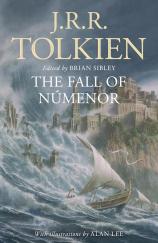The Fall of Númenor: And Other Tales from the Second Age of Middle-earth
Review
The Fall of Númenor: And Other Tales from the Second Age of Middle-earth
» Click here to read Ray Palen's review.
Christopher Tolkien would hold the torch of his father’s legacy up high, releasing THE SILMARILLION, which bore a chapter on the Second Age. It was further explored in UNFINISHED TALES, and even more within the massive 12-volume History of Middle-earth. Elements of the latter also gave depth to the history of that age, as have Tolkien’s letters on the subject.
A certain television production has undertaken to tell a story set within the Second Age of Middle-earth, and it is more renowned for what it gets woefully wrong as opposed to what it gets right. These errors, intentional or accidental, are readily obvious to die-hard Tolkien readers who have devoured all the various tomes and pieced together the strands of the wonder tapestry. For those who have journeyed no further than The Lord of the Rings, this will not be as glaring an issue. Such is the problem of the tales of that age being so spread out.
And so Brian Sibley has stepped in and drawn together all the disparate elements of the Second Age and placed them within one easy-to-reference book, THE FALL OF NÚMENOR. Now, for the first time, the great history of the Second Age can be held in your hands all in one go. It is as comprehensive and exhaustive a history as we will ever likely get for the coverage of this time period.
"Brian Sibley has done a remarkable job compiling all of the prior work lovingly labored over by Christopher [Tolkien] and laying it out chronologically to give the best single-volume telling of the Second Age."
Despite Tolkien’s notion that there is not much to tell of the Second Age, he does his own legend a disservice in such a dismissal. What is the content of this time? It begins in the wake of the fall of Morgoth, and his apprentice Sauron fleeing to hide. It is the tale of the rising of the island of Númenor, gifted to men who would be granted long life, allowing them a great time in which to study and learn and grow wiser than normal man, though not have the immortality of Elves. It is about the glory of the Dwarven kingdom in Moria, before the coming of the Balrog. It tells of the founding of the Grey Havens, and of the re-strengthening of Sauron as he builds his tower of Barad-dûr. It tells of the founding of Eregion, and of Lothlórien.
It is also the Age of the forging of the Rings of Power, with the Elven smiths instructed by a disguised Sauron into the style of their crafting, and his corruption of them with the forging of his One Ring. It is the dawning of the Ringwraiths and the war between the Elves and Sauron. It sees Sauron taken prisoner back to Númenor where he corrupts the King and his people, resulting in the drowning of the island. It sees the founding of Rivendell and Gondor, and the ancestors of Aragorn uniting with the Elves to strike out at Sauron in the fabled Last Alliance, where Sauron is defeated for a time, ending the Second Age.
THE FALL OF NÚMENOR is not a novel, and it is not filled with complete and finely structured narrative. It does contain segments of those things, as well as the necessary Tolkien poetry. On the whole, however, the book is fragments and exposition put to paper that lay the groundwork for ideas that were never ultimately expanded upon. They are the bones of the story. For some, this will be a disappointment. However, for those wishing to expand their understanding of Middle-earth and the incredible legend crafted by Tolkien, this is an essential piece to complete that puzzle.
Brian Sibley has done a remarkable job compiling all of the prior work lovingly labored over by Christopher and laying it out chronologically to give the best single-volume telling of the Second Age. That in and of itself makes this a worthwhile book for any Tolkien reader’s shelf. But we cannot overlook the beautiful illustrations gracing the interior created by the incomparable Alan Lee. Once again his artwork adds beauty to the pages and helps visually bring Tolkien’s dream to life for readers.
THE FALL OF NÚMENOR is dedicated to Priscilla Tolkien, the last of Tolkien’s children, who passed away prior to the book being completed. She was, like Christopher, a stringent advocate for her father’s work, and it is a touching and fitting tribute that she be honored with these pages. What now will become of the Tolkien legacy? Those directly connected to him are now gone, so we will have to wait and see to what level of integrity any further entries will bear.
For now, however, this most recent release is exemplary and should be proudly displayed amongst the preceding volumes. If ever you wanted to explore Middle-earth in its darkest age, you will never have a journey more easily undertaken.
THE FALL OF NÚMENOR, originally written by J. R. R. Tolkien and now expertly edited by Brian Sibley, is an amazing spectacle to behold, and fans of the immortal Lord of the Rings series will not want to miss out on it. The illustrations in watercolor and pencil by Alan Lee are simply breathtaking and enhance the text throughout.
Christopher Tolkien, who passed away in 2020 at the age of 95, dedicated much of his life to collecting the work of his father and correctly chronologizing the history of Middle-earth through dozens of books. Season one of “The Lord of the Rings: The Rings of Power” on Amazon Prime Video depicts Númenor in all its glory, long before its fall. This terrific series and THE FALL OF NÚMENOR owe complete thanks to Christopher, for without him there would have been no tales to share of the Second Age of Middle-earth.
"This is a fantasy adventure of the highest order, and no part of this collection fails to exhilarate.... As a lifelong fan of Tolkien’s work, I was thrilled from cover to cover and did not want this epic history to end."
The book opens with a passage taken from THE FELLOWSHIP OF THE RING, in which the Council of Elrond recounts the legend of the Rings of Power as they discuss how to dispose of the most powerful of the lot --- the One Ring, which was created personally by the evil Sauron himself. Elrond also makes reference here to Númenor and the return of the Kings of Men to Middle-earth.
Númenor is said to have been formed in the 32nd year of the Second Age by Elrond’s twin brother, Elros. This also laid the foundation for the relationship between the growing ranks of Men and the slowly waning age of the Elves. Even the beasts who dwelled on the island were unique, and had a special relationship and mutual respect for the Men who shared this place with them.
The language of Númenor was, in the main, derived from the speech of the people of the House of Haldor and much influenced by Elven tongues at different periods. We learn of the reign of the first Queen of Númenor, Tar-Ancalimë. Her son, Tar-Súrion, eventually would become its ninth ruler.
The story takes a turn into a topic beloved by Lord of the Rings fans when Sauron rises to power, and we witness him initially forging the Rings of Power. Sadly this also will foreshadow the eventual demise of Númenor at his very hands. The book outlines how the Nazgûl, or Ringwraiths, were actually once mighty men of Númenor who had been drawn to the service of the dark lord. The scenes leading up to the drowning of Númenor as it is pulled into a dark abyss are mind-blowing and beyond suspenseful. This is a fantasy adventure of the highest order, and no part of this collection fails to exhilarate.
THE FALL OF NÚMENOR is the result of many years of tremendous research, which is also outlined in two Appendices and a series of important Notes at the end of the narrative. As a lifelong fan of Tolkien’s work, I was thrilled from cover to cover and did not want this epic history to end.
Reviewed by Stephen Hubbard and Ray Palen on November 18, 2022




